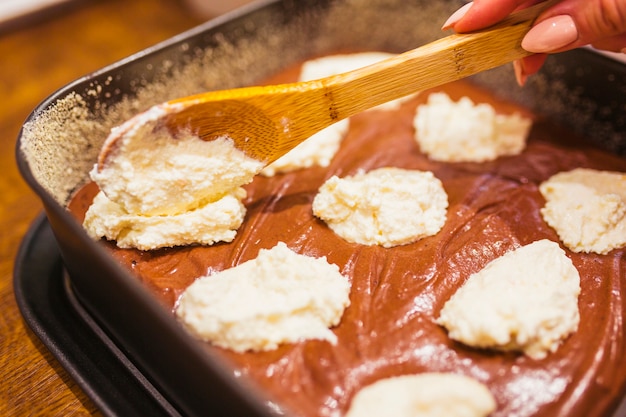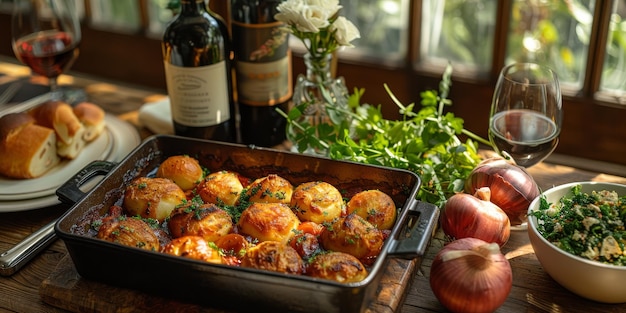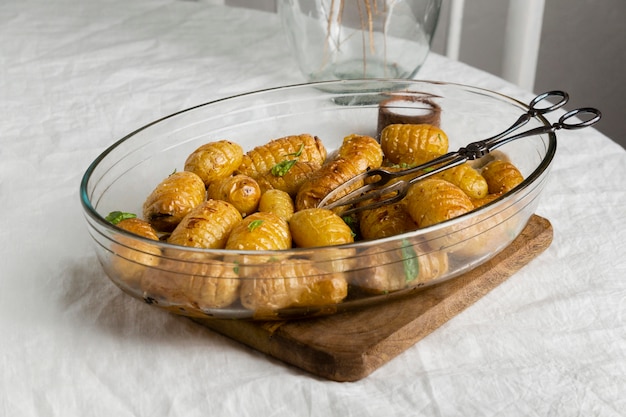Let's face it, we all love a good meatball. Whether it's a classic Italian-style meatball smothered in a rich tomato sauce or a flavour-packed Asian-inspired version with a sweet and spicy glaze, there's something about a perfectly cooked meatball that just hits the spot. But, as someone who's cooked their fair share of meatballs, I know the struggle is real. You want those juicy, flavour-packed beauties, not dry, overcooked lumps. That's where oven-baking comes in, saving you from the endless stirring and potential for disaster.
So, grab your apron, gather your favourite ingredients, and let's get into the nitty-gritty of oven-baked meatballs. We'll be diving deep into everything from crafting the perfect meatball mix to nailing that optimal cooking time and temperature, all while keeping things simple and easy to follow. We'll even explore some exciting variations and toppings, so get ready to unleash your inner culinary genius!
(Part 1) The Importance of the Right meatball recipe

As much as we all love a good shortcut, there's no escaping the truth: a great meatball starts with a great recipe. Over the years, I've experimented with countless meatball recipes – from the basic, meat-and-breadcrumbs combo to more elaborate ones loaded with cheese, herbs, and even vegetables. But one thing I've learned is that the secret to a perfectly cooked meatball is a well-balanced blend of ingredients.
Meat Matters
First things first, let's talk meat. For that juicy, flavour-packed meatball, I'm a firm believer in a mix of ground beef and pork. The beef adds that hearty, familiar flavour, while the pork brings a lovely richness and juiciness that just melts in your mouth. Of course, if you're feeling adventurous, don't be afraid to play around with other ground meats like lamb, chicken, or even turkey. Just remember to adjust the seasoning accordingly to match the unique flavour profiles of each meat.
Don't Forget the Binders
Now, onto those crucial binders – the backbone of a well-structured meatball. Breadcrumbs and eggs are the classic combo for a reason. They help to hold the meatballs together, giving them a pleasing texture, while adding a bit of richness to the mix. However, don't be afraid to experiment with other binders like oats, crushed crackers, or even cooked rice. Just make sure you don't overdo it, as too much binder can lead to dry, dense meatballs – a culinary crime no one wants to commit!
The Right Seasoning
Finally, we reach the exciting part – seasoning. This is where you can truly make your meatballs your own. Imagine the fragrant aroma of garlic and onion, the refreshing punch of parsley and oregano, the earthy depth of basil… The possibilities are endless! Just remember, a little goes a long way. Start with a small amount of your favourite seasonings and adjust to taste. Trust me, you'll be surprised at how a few carefully chosen spices can transform a simple meatball into a culinary masterpiece.
(Part 2) Forming the Perfect Meatball

Now that you have your meatball mix ready to go, it's time to turn it into those iconic round shapes. This might seem simple enough, but believe me, there's a bit of an art to forming the perfect meatball.
Hands-On Approach
For me, there's no better way to form meatballs than with your own two hands. It allows you to get a feel for the consistency of the mixture and ensures that each meatball is evenly shaped, reducing the chance of uneven cooking. Simply scoop a small amount of the mixture into your palm, roll it into a ball, and repeat until you've transformed your meatball mix into a batch of perfectly rounded beauties. If the mixture feels a bit sticky, a quick dip in cold water can make it easier to work with.
Size Matters
The size of your meatballs plays a crucial role in cooking time and consistency. Personally, I prefer meatballs that are about 1.5-2 inches in diameter. This size ensures even cooking and prevents the meatballs from becoming overly dense, resulting in a juicy, flavorful bite. If you're making smaller meatballs, you'll need to reduce the cooking time, and for larger ones, you'll need to increase it. Keep this in mind as you're shaping your meatballs and adjust your cooking time accordingly.
(Part 3) The Importance of Pre-Heating the Oven

Before you even think about throwing those meatballs into the oven, remember the golden rule of baking – preheating! A hot oven is essential for evenly cooked meatballs with a beautiful golden-brown crust. It's the difference between a perfectly cooked meatball and one that's undercooked on the inside and overcooked on the outside.
Make sure you set the oven to the correct temperature, which usually falls between 350°F (175°C) and 375°F (190°C), depending on the recipe and the size of the meatballs. Always double-check the recipe for recommended temperatures, and for ultimate accuracy, use an oven thermometer to ensure that your oven is indeed reaching the correct temperature.
(Part 4) The Ultimate Guide to Oven Meatball Cooking Time
Now, let's get down to the nitty-gritty - cooking time. This is where things can get a little tricky, as the perfect cooking time varies depending on the size of your meatballs, your oven's temperature, and the specific recipe you're using. But, don't worry, I'm here to equip you with some general guidelines to ensure your meatballs turn out perfectly cooked every time.
General Oven Meatball Cooking Times
| Meatball Size | Cooking Time |
|---|---|
| 1.5 inches | 20-25 minutes |
| 2 inches | 25-30 minutes |
| 2.5 inches | 30-35 minutes |
Keep in mind that these are just estimates, and you'll need to adjust the cooking time based on your specific situation. Remember to flip the meatballs halfway through cooking to ensure even browning on all sides. No one wants a lopsided, unevenly cooked meatball!
(Part 5) Signs of Perfectly Cooked Meatballs
Your meatballs are in the oven, and you're eagerly waiting to dig in. But how do you know when they're ready? Don't worry, there are a few telltale signs to look out for that will signal your meatballs are perfectly cooked and ready to devour.
Firstly, your meatballs should be cooked through, with no hint of pink inside. You can easily check this by slicing one open with a knife. Secondly, they should feel firm to the touch. If they're still soft, they need a bit more time in the oven. Finally, your meatballs should have a beautiful golden-brown crust, a sign of those flavorful juices being locked inside.
(Part 6) How to Prevent Overcooked Meatballs
Let's face it, we've all been there – biting into a dry, tough meatball that feels more like chewing on a rubber band than a satisfying meal. It's a tragedy we must avoid! So, how do we prevent this culinary disaster and ensure our meatballs are juicy and flavorful?
First, keep a watchful eye on your oven temperature. If it's too hot, the meatballs will cook too quickly, increasing the risk of drying them out. Secondly, don't overcook those meatballs! Once they're cooked through and have a lovely golden-brown crust, they're ready to come out of the oven. Remember, a little patience goes a long way when it comes to achieving those perfect, juicy meatballs. Third, consider using a meat thermometer to check the internal temperature of your meatballs. They should reach an internal temperature of 160°F (71°C). This will ensure that they're cooked through and safe to eat, while also preventing them from becoming dry and tough.
(Part 7) meatball variations
Now, let's get creative! The world of meatballs is a wonderfully diverse one, and there are countless variations on the classic recipe to explore. So, let your imagination run wild and don't be afraid to experiment! Here are a few ideas to get you started:
italian meatballs
The undisputed king of meatballs, the Italian meatball is a true classic. Typically made with a blend of ground beef and pork, breadcrumbs, eggs, grated Parmesan cheese, aromatic garlic and onion, and a touch of oregano and basil, it's often served with a rich tomato sauce that perfectly complements its flavour. A timeless favourite for a reason!
Swedish Meatballs
Swedish meatballs offer a delightful twist on the classic. They're typically made with a mix of ground beef, veal, and pork, and often include a touch of breadcrumbs, milk, and onion. What truly sets them apart is the creamy mushroom sauce that's usually served alongside, adding a rich, earthy dimension to the flavour profile. It's a true delight!
greek meatballs
Keftedes, as Greek meatballs are known, bring a unique Mediterranean flair to the table. They're often made with ground lamb, breadcrumbs, finely chopped onions and garlic, parsley, and a blend of spices like cumin and coriander. The result? A flavorful, aromatic meatball that's often served with a refreshing tzatziki sauce, adding a cool, tangy contrast to the warmth of the meatball. A true taste of Greece!
Asian Meatballs
Asian meatballs are a testament to the diversity of flavours across the continent. They can be made with different types of meat, from pork and chicken to fish, and are often seasoned with a vibrant blend of soy sauce, ginger, garlic, and chillies. They're frequently served with a sweet and spicy glaze, adding a layer of complexity and excitement to the dish. A must-try for anyone seeking bold and flavourful experiences!
(Part 8) Delicious meatball toppings
Your perfectly cooked meatballs are ready, and now it's time to get creative with those finishing touches! Topping your meatballs is a fantastic way to add a burst of flavour and texture, turning a simple dish into a culinary adventure. Here are a few of my personal favourites:
- Tomato Sauce: A classic for a reason! A rich, tangy tomato sauce is the perfect way to enhance the flavour of any meatball, creating a comforting and familiar taste.
- alfredo sauce: For those who appreciate a touch of decadence, an Alfredo sauce is a superb choice. Rich and creamy, it adds a luxurious element to the dish, coating the meatballs in a velvety embrace.
- Basil Pesto: For those who love the bright, herbaceous flavours of basil, a pesto topping is a must-try. The vibrant green sauce adds a burst of freshness and a touch of earthiness, complementing the meatball beautifully.
- Ranch Dressing: While it may seem surprising, ranch dressing is a surprisingly delicious topping for meatballs. It adds a tangy and creamy element, contrasting beautifully with the savory meatball flavour.
- Blue Cheese Dressing: For the adventurous foodie, blue cheese dressing is a bold choice. Its strong, pungent flavour is an acquired taste, but those who appreciate it will adore the depth and complexity it adds to the dish.
- Spicy Sriracha Sauce: If you enjoy a bit of heat, a drizzle of spicy Sriracha sauce is a must-have. The fiery kick adds an exciting dimension to the dish, waking up your taste buds.
- Honey Mustard Sauce: For a more subtle flavour, a honey mustard sauce is a great choice. The sweet and tangy combination balances the savory notes of the meatball, creating a harmonious symphony of flavours.
(Part 9) Serving Suggestions
Now, your delicious meatballs are ready to be enjoyed! The beauty of meatballs is their versatility – they can be incorporated into a variety of dishes, making them a culinary chameleon that adapts to any occasion. Here are a few ideas for serving up your meatball masterpiece:
- Over Pasta: A classic and satisfying way to enjoy meatballs. Toss them in your favourite pasta sauce and serve over a bed of spaghetti, penne, or rigatoni for a comforting and flavorful meal.
- On a Sandwich: Transform your meatballs into a delicious meatball sub with your favourite toppings. Pile them high on a crusty roll, add some melted cheese, your favourite sauce, and a few crisp vegetables for a satisfyingly messy and delicious sandwich.
- In a Salad: Add meatballs to your favourite salad for a hearty and flavorful meal. The savory meatballs add a satisfying protein boost, while the salad provides a refreshing contrast of textures and flavours.
- With mashed potatoes: A comforting and classic pairing that always hits the spot. The creamy mashed potatoes complement the savory meatballs perfectly, offering a satisfying and comforting combination.
- With Rice: A simple and versatile way to serve meatballs. Serve them alongside a bed of rice, either plain or seasoned with your favourite herbs and spices, for a balanced and flavourful meal.
(Part 10) FAQs
Now, let's tackle some frequently asked questions about oven-baked meatballs, ensuring you have all the knowledge you need to create a meatball masterpiece!
1. Can I freeze meatballs before cooking them?
Absolutely! Freezing meatballs before cooking is a great way to have a stash of ready-to-cook goodness on hand. Just make sure they're completely cooked through before freezing. To freeze them, place them on a baking sheet lined with parchment paper and freeze for about 2 hours. This will prevent them from sticking together. Once frozen, transfer them to a freezer-safe bag. To cook them from frozen, add 5-10 minutes to the cooking time.
2. Can I add cheese to my meatballs?
Cheese is a delicious addition to any meatball recipe! You can add shredded cheese to the meatball mixture for a subtle cheesy flavour throughout, or you can stuff the meatballs with cheese before cooking them for a burst of cheesy goodness in every bite. Just make sure the cheese is fully melted and cooked through. Pro tip: choose cheeses that melt well, like mozzarella, cheddar, or provolone.
3. What if my meatballs are sticking to the baking sheet?
If your meatballs are sticking to the baking sheet, it's likely because the baking sheet isn't greased or lined with parchment paper. To prevent sticking, make sure to grease the baking sheet with a bit of cooking spray or oil before you add the meatballs. Alternatively, you can line the baking sheet with parchment paper or aluminum foil for easy cleanup and to prevent those pesky meatballs from sticking.
4. Can I bake my meatballs in a smaller oven?
You can certainly bake meatballs in a smaller oven, but you may need to adjust the cooking time. Smaller ovens tend to heat up faster, which can lead to faster cooking times. Keep a close eye on your meatballs and check for doneness after about 15 minutes. If they're browning too quickly, consider reducing the oven temperature by 25 degrees Fahrenheit.
5. What if my meatballs are browning too quickly?
If your meatballs are browning too quickly, it's likely because the oven temperature is too high. Reduce the oven temperature by 25 degrees Fahrenheit and check the meatballs again after 5-10 minutes. If they're still browning too quickly, you can try tenting the baking sheet with aluminum foil to help slow down the browning process. This will create a barrier between the meatballs and the direct heat of the oven, allowing them to cook more evenly.
And there you have it, folks! My ultimate guide to oven-baked meatballs, packed with tips, tricks, and variations to help you create culinary magic in your own kitchen. Remember, the key is to have fun, experiment, and don't be afraid to try something new. Get creative with your ingredients and toppings, and most importantly, enjoy those delicious meatballs! Happy cooking!
Everyone is watching

Corn on the Cob: The Ultimate Guide to Perfectly Cooked Ears
Healthy MealsAh, corn on the cob. Just the name evokes images of sunny days, barbecues, and that sweet, juicy flavour that ...

Perfect Pork Roast Oven Cooking Time: A Guide to Delicious Results
Healthy MealsThere's something truly satisfying about a perfectly roasted pork. The aroma alone is enough to make your mout...

Ham Cooking Time: How Long to Bake, Smoke, or Boil a Delicious Ham
Healthy MealsAh, ham. It's a classic, isn't it? A real crowd-pleaser, especially around holidays. And when done right, it'...

Scallops: The Ultimate Guide to Perfect Cooking
Healthy MealsAh, scallops. Those delicate, sweet, and utterly delicious morsels of the sea. They hold a special place in my...

Spaghetti Squash: The Ultimate Guide to Cooking and Serving
Healthy MealsRemember that time you saw spaghetti squash at the supermarket, looking all bumpy and strange, and thought, "W...
